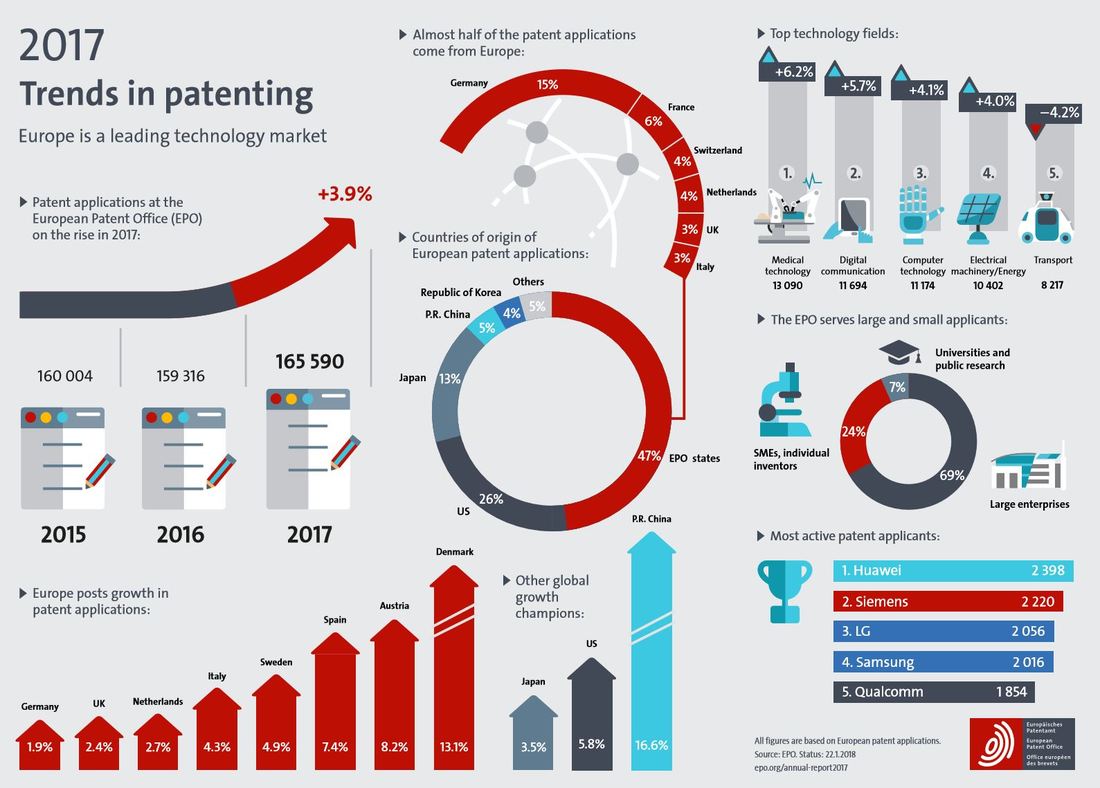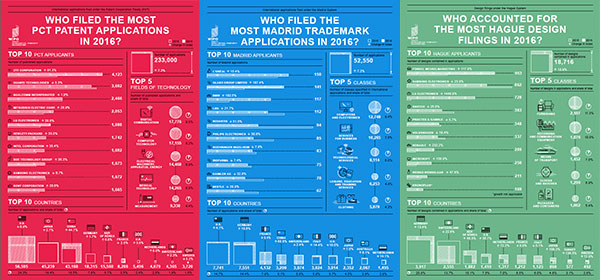There is a chicken-egg-interdependency of business- and Intellectual Property strategy. This explains, why IP-strategy discussions without a deep understanding of business makes no sense. Seeking the core of business transformation in digital technology adoption only is not enough. The Intellectual Property Strategy will likely decide who takes control on the whole value chain and the underlying business model - who sits in the front seat and who must find a place on the backbench. Even though that patents represent a part of innovation only, they still indicate where the energy is in a respective geography, industry, or even company. The annual reports of patent offices provide some interesting perspectives worth exploring. The factory of the future will have only two employees, a man, and a dog. The man will be there to feed the dog. The dog will be there to keep the man from touching the equipment.
With the separation of Software from Hardware arriving in automotive industry, a whole set of new proprietary software with respective End User Licensing Agreements (EULA) will be coming down the road. It seems we soon have to familiarize ourselves with the fact that we can´t own a car entirely anymore - primarily not because we all move into the share economy model but driven by the fact that the car manufacturer will no longer own or control the required software IP. Automotive Industry for years pushed towards external innovation and external labor to reduce capital lockup - Software IP will be a game changer for car vendors who want to keep control on their core business. This idea is intriguing us because manufacturers need to go beyond selling physical car assets and must discover us drivers as customers - welcome to next generation Customer Relationship Management and the essence of customer intimacy for an old economy! However, transformation in software industry is going deep as well. What has worked in a traditional productized Sell-To model needs to get complemented by Sell-With and Sell-Through approaches to meet the new customer expectations. Software IP gets embedded in products, cloud-based services become essential part of other products or your current customer may want to join forces with you on innovation. Either way, it´s time to revise value propositions, to reskill the salesforce and to tune the commercial backbone towards new ways of monetization. Digital Transformation, Industry 4.0 and a solid IP Strategy belong together and form the common ground for your business in near future, so let´s prepare for it now. Good news, the cheese may already have moved on but the opportunity maybe bigger than ever and the driver seat is not decided yet!
3 Comments
High-Tech Industry also realizes it´s Semmelweis reflex on data protection and digital security and collectively started washing hands in a metaphorical sense to fight most recent super bugs like Spectre and Meltdown. Bugs and viruses in software, micro code or silicone can´t get prevented by washing hands, however, the traits of hygiene well translate into (software-) engineering disciplines since, it is a concept of clean separation of entities. The skilled cut of a surgeon or the smart hack of an engineer are admirable but certainly not the only definition of success. The collective realization is needed that, data privacy is tightly connected with security and ultimately safety. New definitions of performance are needed since, what we face is not a technological crisis only. Recent Facebook hearing shows the need for clean separation, all the way from business models to digital implementation and makes the conflict of public, private and economic interests evident. Given the opportunity cost of cyber crime, major data breaches, political destabilization or global financial crisis, we -societies, industries or markets- should overcome the Semmelweis reflex and establish common norms and standards for Trustworthy Computing.
Fix a problem before regulation makes it a crisis. It will probably take time to reach consensus in High-Tech Industry but, meanwhile let´s keep washing hands and remind all parties on the essence of integrity: Doing the right thing, even when no one is looking!
No matter where you start doing things differently it will be a journey without final state of perfection. My personal experience in software industry started with empowerment, trust, investment and an innovative environment - all invaluable assets to be successful and certainly something to secure to back your own digital transformation! The New World of Work offers more than saving commute time and a better CO2 footprint for the individual. It´s certainly more than saving office space, reducing travel cost and increasing employer attractiveness scores. Optimizing work and life for more productivity means a fundamental change of habits - professionally and privately. The problem is not the problem. The problem is your attitude about the problem - Do you understand me? Let´s not confuse, the digital transformation of our work- and lifestyle remains a cultural challenge, a social responsibility and it mandates innovation in leadership approaches. What may work on an individual- or team level requires a more systematic effort to organizational structures. Conventional Change Management is not sufficient to address the topic says Barbara Josef, Partner at 5to9. It requires general management attention to orchestrate the cultural transformation and realize the productivity potential. All functions from IT, Finance, HR and the Line Organizations need to be onboard and synchronized. Make sure, you keep it simple and rational in your approach to policies.
"Now that it's definitely not cool anymore, it feels safe for me to start tweeting as well ..." During my career, I had the pleasure to work in mobile workplaces, use flexible- and drop-in offices, collaborate during intense travel, perform in international roles, manage remote teams, lead business in distributed environments and experience diverse cultures. Still, I keep exploring, learning, optimizing and innovating my environment - always aware that there will be no perfect time to try new things. The next big transformation in sales is within reach. Therefore, I dive deep into Artificial Intelligence to further benefit Business Insight and, I look into seamless channel integration to imagine teamwork with our future colleagues, the AI Bots. If sales can add value to customers through well articulated procedures, repetitive activities and standardized offerings, than the combination of new technology with experienced sellers will lead to new exciting ways of customer experience.
Account Planning means planning for results. In a number driven world of sales, the decomposition of an aspired revenue goal is psychologically the first step to accepting the challenge. While SMART goals and respective objectives may well fit on a small napkin, they by no means are the plan. I would even argue that it is the wrong end to start with - relevant account plans are starting with the customer. In recent years, Business-to-Business sales has evolved in various dimensions, redefining how we engage with customers:
Account Planning is a reflection on the evolution in sales but even more, so it is a yardstick on the sophistication of your teams work - what a great coaching opportunity or moment to personally benefit the customer relationship in form of executive sponsorship. Imagine the business potential of getting the perception right by moving away from a necessary evil and abandoning the disrespect which a napkin implies.
Looking back, the focus remained on strengthening the status quo of computing capability towards faster, better, cheaper - neglecting the fact that in a current world of predominantly linear computing requirements the availability of resource no longer remains the limit for businesses - instead, time is the ultimate scarce resource.
Moors law keeps democratizing affordable compute resource and turns blessing into obligation. It´s an obligation to make better use of affordable digital resource within shorter innovation cycles. In a cloud based world, which is trending towards zero marginal cost and global reach (as predicted by Jeremy Rifkin) - the better business model innovator with the fastest implementation wins - The Race is On!
In skating over thin ice our safety is in our speed.
That doesn't mean that business experts need to become technical experts, but it does mean that business people need to get serious about understanding the core of technologies that they use to run their mission and into the right direction.
How is your own digital fitness level doing and what approach are you taking to lead in the digital era?
When it comes to digital, the only thing worse than standing still is running in the wrong direction.
In sales business this is true as well, it comes down to the everlasting question of Art & Science. The fine arts of dealing with people, emotions, expectations and the fact based, systematic, scientific approach. Provocatively speaking, neither wine & dine nor bean counting is the answer. The journey towards the right blend is the master discipline in sales leadership, since it is closely connected to both, organizational culture and customer intimacy. Diversity needs room in every healthy organization but it must reside with the people and perspectives. It is not defined by the variety of proprietary spreadsheets in a room. We all have attended far too many meetings which did not follow the courses of action. Actually, it´s great to rely on intuition and discuss different standpoints but let´s calibrate it with insight, driven by relentless curiosity – trying to avoid justifying ones own personal bias. In memory of Hans Rosling, the founder of gapminder.org, who recently passed away: “I want to talk about mindset; Does your mindset correspond to my data set? – if not, one or the other needs an upgrade!” [TED 2009]. Keep it simple for all parties: What can you do in your next business meeting to stimulate the customer mindset and concrete plan of action through valid and compelling facts? – Think about it!
|
Andreas Engelis an experienced business leader working 25+ year in high-tech industry - leading, growing and transforming high-performance sales organizations, balancing short term results with long term strategy to drive new business growth. CATEGORIES
All
ARCHIVES
April 2020
|














